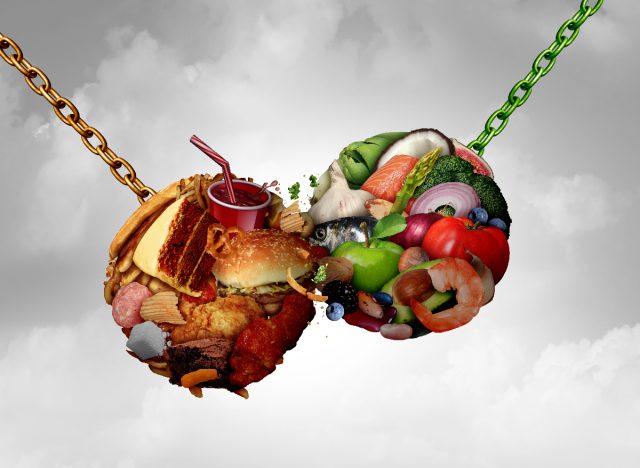Are you doing more harm than good to your overall health and wellness? If your waist measurement is 40 inches or greater, you may be at risk of cancer, type 2 diabetes, and other serious health conditions, according to Hartford HealthCare. An average waistline for adults in the U.S. equals 36 inches. There are everyday habits that give you a bigger waistline, according to science, that you should be aware of. Read on to learn more.
Research performed by the International Agency for Research on Cancer, affiliated with the World Health Organization (WHO), indicates that a larger waistline bumps up your risk of type 2 diabetes, and obesity-related types of cancer. The cancers include esophageal, gallbladder, prostate, stomach, kidney, liver, pancreatic, and ovarian. Dr. Peter Yu, physician-in-chief for the Hartford HealthCare Cancer Institute explains (via Hartford HealthCare), “It’s become clear that however you measure excess body weight, obesity increases the risk of cancer and the risk of cancer recurrence after treatment.” Dr. Yu adds, “Obesity impacts the body’s immune system and metabolism in ways that cause cancer problems.”
Typically, a normal BMI measurement is between 18.5 and 24.9. Obesity means a BMI of 30 or greater. If you have four or more extra inches around your belly, it’s important to take time to lose some weight and decrease your health risks. According to Dr. Yu, “Energy balance, which is matching your consumption of calories to your daily exercise levels, is a key component of a healthy lifestyle. Reducing calories together with increasing exercise is more likely to result in weight loss than either one alone.”
Now, let’s get into some everyday habits that give you a bigger waistline and are harmful to your health, according to science. It’s never too late to start incorporating changes in your routine.


There’s a very good chance you’re eating and drinking more sugar than you realize. Sugar is totally not your friend, and it hides in many of your favorite items. The sneaky thing is some of the items are perceived as healthy, such as protein and granola bars, yogurt, breakfast cereals, energy drinks, and fruit juices, according to Healthline. Did you know that some specialty coffees are linked to higher visceral fat? Or that two 16-ounce cans of soda contain a whopping 104 grams of sugar?
Too much of anything is not good for you, but it’s a great idea to limit your sugar content on a daily basis. Also, be mindful of what’s on the ingredient list of the items you purchase.
Related: Best-kept Exercise Secrets for a Smaller Waist at 50, Expert Reveals


Okay, most people enjoy a glass of wine or two with their dinner. Hey—research has even shown that sipping red wine can lower your chances of developing heart disease (via Healthline). But enjoying too many glasses leads to excess weight gain, along with other health conditions. There are many alcoholic beverages that are high in calories.
When it comes to drinking wine, a 5-ounce glass of chardonnay, sauvignon blanc, or pinot grigio is 120 calories, according to Diet v.s. disease. Your favorite cabernet or zinfandel will cost you 125 calories. Any sweet wine is 160 calories per glass. You get the picture. Limit how much you drink, and once you cut back, you will start to see a difference in your belly!
Related: Get Rid of Your Waistline Bulge With This Kettlebell Workout
READ RELATED: Simple Everyday Habits To Slow Down Muscle Aging, Expert Reveals


Maintaining an irregular eating schedule can contribute to added visceral fat, impacting your waistline and overall health. (Excess visceral fat is linked to a heightened risk of metabolic syndrome; prostate, colorectal, and breast cancers; Alzheimer’s; cardiovascular disease; and type 2 diabetes, according to Jenny Craig)
It’s not a good idea to skip some meals and eat more than you should during others. Unhealthy eating patterns can increase your stress levels and negatively modify your gut microbiota.


We totally get it: You love binge-watching your favorite TV shows. But staying sedentary for too long on a regular basis is never a good thing. It’s important to have downtime to let your body and mind relax and recharge from a busy week, but choose your activities wisely. In fact, research from the University of Minnesota School of Public Health reveals that watching TV for one and a half hours translates to around 3.5 cubic centimeters of extra abdominal fat. Eek!
Rather than kicking back on the couch on the regular, consider getting in some healthy physical activity. You can set up some candles and do a yoga flow, head outside for a walk while listening to your favorite audiobook, or take your pup for a short hike.


This leads us to our next point in the everyday habits that give you a bigger waistline: You’re not exercising as much as you should be, if at all. Not getting in a workout regularly is detrimental to your health and the size of your waist.
A brisk walk or simply one hour of exercise goes a long way to slimming down. In fact, one study on overweight individuals indicates that hopping on a stair-climber two times a day for just five consecutive minutes dropped around 7.3 pounds of body weight in a mere three weeks.


Last but not least in the everyday habits that give you a bigger waistline has to do with eating too much of the wrong foods. Everyone who wants to reduce their waistline needs to reduce their calorie intake. It’s important to include more veggies, fruits, and whole grains in your diet and cut out items that just aren’t healthy, according to Mayo Clinic. (Your mind and body will thank you!)
A plant-based diet that features foods like legumes, nuts, seeds, and fresh fruits and veggies is always a healthy choice. You can also add items like fish and low-fat dairy to your weekly rotation. And of course, be sure to limit your consumption of chicken and red meat.
If you’re a female who’s in your 50s, it’s important to reduce your calorie intake by about 200 each day just to preserve your current weight and figure, Mayo Clinic reports. If you want to lose a few pounds, you may need to cut out more. Always be mindful of what you’re putting into your body, and treat it with TLC!
Source:










